Hollow words aims to create a tool which displays diversity of news reports in a more creative and broader spectrum as to recognize the importance and ability to not get lost in our own echo chambers. It displays the external but also the internal perception, but in context of delayed time. The core of the installation is the evaluation of collected news article data using Natural Language Processing (NLP).
Every day, we are surrounded by news feeds, whether we want to consume them or not. Due to the amount of various news feeds it’s difficult to still stay neutral to the facts and not get manipulated by them in any form. Despite the same facts within the reports, it seems that every credible newspaper has its own pattern to present the events to its consumer.
The style of writing contributes a significant but subtle difference in the end. Key institutions like media representatives play a central role in the dissemination and the maintenance of ideologies. They create narratives and discourses about social processes which contribute significantly to the general awareness-building. In doing so, the media not only disseminate information, as it is often assumed in the mainstream of economic media research to be its sole function. Primarily, it is a fundamental contribution to the construction of social reality. The role of the media system is thus all-encompassing in the sense that the form of “reality” with which we are familiar would often be unthinkable or inconceivable without the media system itself.
In other words, people are referred to the media system and to media representation, since the real environment as a whole is too complex and diverse to be directly experienced. It is for that reason why we want to create a tool that analyses the style of writing in reports from various credible newspapers and try to display the resulting diversity in an artistic way.
We want to contribute an idea to create a tool which displays diversity of reports in a more creative and broader spectrum as to recognize the importance and ability to not get lost in your own echo chamber. Furthermore, it’s important to introduce the term it’s all hollow words which comes from the German idiom das ist alles Schall & Rauch. It is a major piece of the building blocks which we want to implement within our concept. Metaphorically, it displays the external but also the internal perception, but in context of delayed time. The delayed time explains the process of extending the field of vision or extending circumspection which everyone knows after studying something more intense. Your imagination shifts and someone maybe realizes: I know that I know nothing.
Technical Narrative
The user is located in the center of circularly arranged screens. The diameter is currently not defined and depends on the size and number of output devices (8 to 16 screens, yet optional). The circular arrangement shall display our natural perception of awareness for information. As someone stands in the middle of the circle, the amount of information input is at its peak – at this point, noone is able to get detailed and credible information.
Each screen has a distance sensor that determines the current position of the user. In case the user is located in the center of the circle, they will be provided with an overview of current topics in readable form distributed over all screens. Once the user moves closer to a screen, the content changes and provides a more detailed breakdown of a topic. All unrelated topics disappear. If the user stands directly in front of a screen, they have the maximally available insight into a topic.
The core of the entire installation is the evaluation of collected news article data using Natural Language Processing (NLP). Different libraries such as NLTK or NLP Stanford can be used for the analysis. In most cases, different evaluation techniques lead to a numerical result. These values are stored associated with the respective analyzed article.
Credits
Friedrich Bachinger, Arno Deutschbauer
Hollow Words received an honorary mention for the 2020 Ars Electronica Futurelab Ideas Expedition
